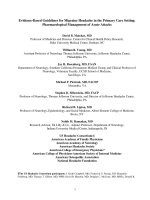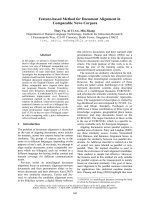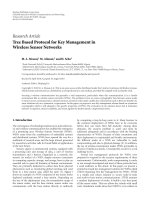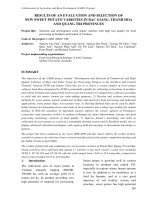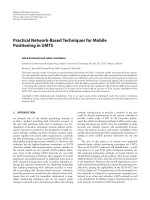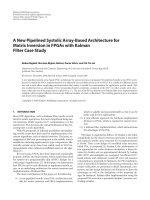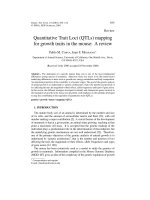Finger millet (Eleusine coracana G.) based intercropping for food security in Konkan region - A review
Bạn đang xem bản rút gọn của tài liệu. Xem và tải ngay bản đầy đủ của tài liệu tại đây (236.48 KB, 13 trang )
Int.J.Curr.Microbiol.App.Sci (2019) 8(1): 3065-3077
International Journal of Current Microbiology and Applied Sciences
ISSN: 2319-7706 Volume 8 Number 01 (2019)
Journal homepage:
Review Article
/>
Finger Millet (Eleusine coracana G.) based Intercropping for Food Security
in Konkan Region -A Review
S.B. Bhagat, A.V. Dahiphale*, N.V. Mhaskar, D.G. Jondhale and M.C. Puri
Dr. Balasaheb Sawant Konkan Krishi Vidyapeeth, Dapoli – 415 712,
Dist. Ratnagiri (Maharashtra), India
*Corresponding author
ABSTRACT
Keywords
Eleusine coracana,
Intercropping,
Food security
Article Info
Accepted:
26 December 2018
Available Online:
10 January 2019
In recent years, there has been increasing recognition of the importance of millets in India,
since major cereals which are grown on good soils supplied with large quantity of
fertilizer, irrigation and pesticide inputs have attained yield plateau. Millets have
potentiality of contributing to increase food production, both in developing and developed
countries. In general, millets are rich in many minerals besides their better adaptability to
adverse growing conditions. Millets are cultivated mainly as rainfed crop. However, these
are especially valued for filling specific niches because they often succeed under stressful
situation where other crops fail to produce an acceptable harvest. Among different millets
finger millet has capacity to produce consistent yield, even without special care. It is
considered as poor man’s food and also recommended as the food for person suffering
from diabetes due to its medicinal value. For assessment of intercropping (two crops only),
different indices have been used to determine advantage of an intercropping system over
sole cropping by giving different formulae this paper give the critical review the Finger
millet (Eleusine coracana G.) based intercropping for food security in konkan region.
Introduction
In recent years, there has been increasing
recognition of the importance of millets in
India, since major cereals which are grown on
good soils supplied with large quantity of
fertilizer, irrigation and pesticide inputs have
attained yield plateau. Millets have
potentiality of contributing to increase food
production, both in developing and developed
countries (Shau, 1965). In general, millets are
rich in many minerals besides their better
adaptability to adverse growing conditions.
Millets are cultivated mainly as rainfed crop.
However, these are especially valued for
filling specific niches because they often
succeed under stressful situation where other
crops fail to produce an acceptable harvest.
Among different millets finger millet has
capacity to produce consistent yield, even
without special care. It is considered as poor
man’s food and also recommended as the
food for person suffering from diabetes due to
its medicinal value. Finger millet has some
unique qualities, which make it potentially
valuable product. The straw has an immense
3065
Int.J.Curr.Microbiol.App.Sci (2019) 8(1): 3065-3077
utility as fodder for both draught and milch
animals. It makes good fodder and contains
up to 61% total digestible nutrients
(Upadhyaya, 2006). Nutritional value of
finger millet implies proteins 7.6g, fats 1.5g,
carbohydrates 88g, calcium 370mg, vitamin A
0.48mg, thiamine (B1) 0.33mg, riboflavin
(B2) 0.11mg and niacin (B3) 1.2mg per 100g
of grains.
millet (Ved Prakash et al., 2005). Legumes
have assumed much significance in
intercropping because of their potential for
nitrogen transfer to cereal crop (Giri and De,
1978). Growing groundnut as an intercrop in
finger millet is more profitable than sole
finger millet in Konkan region during kharif
season (Thorat et al., 1986).
Assessment of intercropping indices
In Maharashtra, finger millet occupies an area
of about 120 thousand hectares with an annual
grain production of 109 thousand tonnes with
productivity 908 kg per ha in 2009-10
(Rajendra Prasad, 2012).
It is mainly cultivated in Thane, Raigad,
Ratnagiri, Sindhudurg, Dhule, Jalgaon,
Nashik, Pune, Satara and Kolhapur districts of
Maharashtra. The largest acreage of ragi is in
Konkan region. It is also taken as rabi crop
where irrigation facilities are available. In
Konkan region, finger millet plays an
important role in agriculture with an area of
471 hundred ha with an annual production of
480 hundred tonnes (Deshmukh, 2007).
Intercropping is one of the sure ways of
increasing production without much increase
in the application of inputs. Intercropping
refers to growing of two or more crops
simultaneously on the same piece of land.
This system gives crop intensification of both
time and space. Apart from its advantages like
diversification,
labors
distribution,
maintenance of soil fertility, suppression of
weeds, two major advantages are higher
productivity and greater stability through
utilization of solar energy, moisture and
nutrients. The practice of intercropping in
finger millet will definitely improve the
economy of lower class as it will help them in
fulfilling their own requirements along with
finger millet which they grow on large scale.
Intercropping of finger millet with pigeon pea
at 4:1 ratio resulted in to higher finger millet
equivalent yield compared to sole finger
For assessment of intercropping (two crops
only), different indices have been used to
determine advantage of an intercropping
system over sole cropping by giving different
formulae.
Descriptions of all such indices along with
their formulae, advantage and disadvantage
are presented.
The following symbols have been used in the
formulae of these indices
Yii - Sole crop (pure stand) yield of crop A.
Yjj - Sole crop (pure stand) yield of crop B.
Yij- Intercrop yield of crop A, when grown
with crop B as intercrop.
Yji-Intercrop yield of crop B, when grown
with crop A as intercrop.
aij- Proportion of area allotted to crop A in
intercropping.
aji - Proportion of area allotted to crop B in
intercropping.
Pi- Unit price of crop A.
Pj- Unit price of crop B.
Relative Crowding Coefficient (RCC)
This coefficient was proposed by De wilt
(1960) and examined by Hall (1974a, 1974b).
The RCC is useful for replacement series of
intercropping experiment. RCC for each crop
gives a measure of whether that crop was
produced more or less yield than expected
yield, e.g. RCC for crop A is
3066
Int.J.Curr.Microbiol.App.Sci (2019) 8(1): 3065-3077
Intercrop yield of crop A x Proportion of area
under crop B in intercropping
Where, Ci= Pci/Pw
Kij =
Pci and Pw are per unit prices of ith crop and
wheat, respectively.
(Yield of sole crop A - Intercrop yield of crop
A) x (Proportion of area under crop
A in intercropping)
Aggressivity (A)
Kij=
Yij. aij
(yii – yij) X aij
If kij> 1, then there is yield advantage of crop
A in intercropping. If there is no effect of
intercropping on the yield of crop A, then kij=
1; kij <1 indicates the yield disadvantages due
to intercropping. Similarly, one can compute
kji, RCC for crop B. The component crop with
higher relative crowding coefficient is the
dominant and is more competitive than the
associated crop.
Land Equivalent Ratio (LER)
Aij =
Yij
-
Yii. aij
Yji
Yjj. aji
Willy and Osiru(1972) defined LER as
relative area of the some crop that would be
required to produce the equivalent yield
achieved by intercropping and given by
Yij
LER =
Yji
= Li + Lj
+
Yii
Aggressivity was proposed by Mc Gillchrist
and Trenbath (1971), who extended the work
of William (1962) and Mc Gillchrist (1965).
Aggressivity of crop A with crop B gives the
simple difference between the expected
relative yield only. Aggressivity of crop A
with crop B is given by
Aij =
Intercrop yield of crop A Intercrop yield of crop B
-------------------------------- - -----------------------------Expected yield of crop A Expected yield of crop B
= Expected relative yield of crop A Expected relative yield of crop B
If the aggressivity value of a component crop
with other component crop is zero, then the
two component crops are said to be equally
competitive. Aggressivity value when greater
than zero indicates that one crop is
dominating over the other. As it is based on a
sample difference, the interpretation of
intercropping treatment may become difficult
if the values are identical in different
treatments.
Area Time Equivalent Ratio (ATER)
Yjj
Where, Li and Lj are known as component
LER or partial LERs.
Crop Equivalent Yield (CEY)
Lal and Ray (1976), Verma and Modgal
(1983) proposed economics of crop by
converting grain/seed/fodder etc. in terms of
gross return for valid comparison and
obtained wheat equivalent yield as
Jagannath and Sunderaja (1987) proposed
Area Time Equivalent Ratio
ATER= (Li.ti + Lj.tj)/T
Where, Li and Lj – Partial LERs
ti and tj duration of crop i and j
T = Duration of whole intercropping system
ATER> 1 = intercropping system more
advantageous than monocropping
3067
Int.J.Curr.Microbiol.App.Sci (2019) 8(1): 3065-3077
Yield advantage in intercropping system
Land Equivalent Ratio (LER)
Pradhan and Ghosh, (1988) at Ranchi
(Jharkhand) obtained higher LER (1.51)
under finger millet + black gram mixed
cropping system as compared to finger millet
+ green gram (1.14) mixed cropping system
and that of sole crop (1.00). The higher LER
was recorded under finger millet (cv. EC.423-4) + pigeon pea (cv.T-21) paired row
system as compared to finger millet (cv. PR717) + pigeon pea (cv.Kanke-9) paired row
system and that of sole crop at Bhubaneswar,
Orissa (Parida et al., (1989). Jadhav et al.,
(1992) from Dapoli reported that finger millet
and okra 4:2 intercropping system recorded
higher LER as compared to finger millet +
urd bean 4:2, finger millet + groundnut 4:2
and finger millet + cowpea 4:2. At
Nagamangala (Karnataka), higher LER was
recorded under finger millet + pigeon pea 8:2
intercropping as compared to finger millet +
field bean 8:2 intercropping system and sole
crop of finger millet (Shankaralingappa and
Hegde
1992).
Shankaralingappa
and
Rajashekara (1992) from Bangalore reported
that intercropping of finger millet with
Lucerne 1:1 recorded higher LER as
compared to that of finger millet + field bean
1:1 intercropping system and sole crop of
finger millet.
Itnal et al., (1994) observed that, the LER was
highest (1.41) in intercropping of pearl millet
+ pigeon pea in row proportion of 4:2 with
additive series followed by the same plant
density series in 3:1 row proportion (1.36).
Das and Guha (1996) found that land
equivalent ratio in all intercropping treatments
were higher than pure crop. The highest land
equivalent ratio (1.30) was given by row ratio
2:2 of rape seed + niger. Dubey and Shrivas
(1997) observed that intercropping of kodo
millet + pigeon pea (4:1) gave the highest
seed yield of 793 kg ha-1 after sole kodo
millet 1226 kg ha-1 during all the years and
also the highest kodo millet seed equivalent
yield of 2961 kg ha-1 was recorded in kodo
millet + pigeon pea 2:1 proportion.
On red sandy loam soil at Koraput (Orissa),
Mohapatra and Halder (1998) obtained higher
LER under finger millet + soybean 5:2
intercropping system as compared to that of
3:2 row ratio, finger millet + rice bean (5:2
and 3:2 row ratio) intercropping system and
sole crop of finger millet. Singh and Arya
(1999) at Ranichauri (Uttranchal) observed
that finger millet and soybean mixed cropping
system (9:1 seed mixture) recorded higher
LER (1.35) as compared to finger millet +
rice bean (1.21) and finger millet + rajma
mixed cropping system and sole crop of
finger millet. Finger millet + pigeon pea at 4:1
ratio recorded the highest land equivalent
ratio (1.48) for two years indicating 48 per
cent more land use efficiency over the sole
cropping. Maitra et al., (2001) and Sarangi et
al., (2002) from Berhampur recorded higher
LER under intercropping of finger millet
(medium duration) with pigeon pea (short
duration) (8:2) as compared to finger millet
(medium duration) + pigeon pea (medium
duration) (8:2) intercropping system and sole
crop of finger millet. Ramamoorthy et al.,
(2003a) at Coimbatore (TN) reported that
finger millet + determinant type of field bean
intercropping recorded higher LER (1.48) as
compared to finger millet + field bean
(indeterminant type)intercropping system in
8:2 row ratio LER (1.45) and sole crop of
finger millet LER (1.00). Finger millet +
french bean intercropping recorded higher
LER as compared to finger millet + horse
gram and was on par with those of finger
millet intercropped with peas, soybean,
cluster bean (Girish, 2004). Padhi et al.,
(2010) reported that intercropping system of
pigeon pea (UPAS -120) + finger millet
(Bhairabi) at 2:4 row ratio recorded higher
3068
Int.J.Curr.Microbiol.App.Sci (2019) 8(1): 3065-3077
LER (1.42) as compared to pigeon pea
(UPAS- 120) + finger millet (PR- 202) in 2:4
row ratio. The literature on land equivalent
ratio (LER) clearly indicated that finger millet
intercropped with pigeon pea or soybean or
groundnut recorded higher LER than finger
millet intercropped with green gram, rajma,
rice bean or field bean. Further, LER value
was higher under inter/mixed cropping system
than sole cropping of finger millet.
Crop equivalent yield
Experiment conducted at Dapoli showed
higher finger millet equivalent yield under
finger millet + okra 4:2 intercropping system
as compared to finger millet + urd bean 4:2,
finger millet + groundnut 4:2 and finger millet
+ cow pea 4:2 (Jadhav et al., 1992). At
Bangalore, highest FMEY was obtained under
finger millet + pigeon pea intercropping
system in 8:2 row ratio as compared to finger
millet + field bean intercropping system in 8:2
row ratio and sole crop of finger millet
(Shankaralingappa and Hedge, 1992).
Shivkumar and Yadahalli (1995) at
Bangalore, reported that intercropping of
pigeon pea with finger millet in 5:2 row ratio
gave higher FMEY as compared to that of
finger millet + field bean 5:2 intercropping
system and sole crop of finger millet.
Experiment
conducted
at
Ranichauri
(Uttaranchal) showed higher finger millet
equivalent yield under finger millet + soybean
mixed cropping system (9:1 seed mixture) as
compared to finger millet + rice bean and
finger millet + rajma mixed cropping system
(9:1 seed ratio) and sole crop of finger millet
(Singh and Arya, 1999). Jena et al., (2000) at
Ganjam (Orissa) reported that intercropping
of finger millet with pigeon pea in 4:1 row
proportion recorded higher FMEY as
compared to 5:2 row ratio and sole crop of
finger millet. Shashidhara et al., (2000) from
Hanumanamatti, Karnataka reported that
finger millet + pigeon pea in 4:2 row ratio
recorded the higher FMEY 16.63 q ha-1 as
compared to those of 3:1 (14.86 q ha-1) and
5:1 (15.27 q ha-1) row ratio and sole crop of
finger millet.
Ramamoorthy et al., (2003) conducted field
experiment at Coimbatore and observed that
intercropping of finger millet + field bean
(determinant type) in 8:2 row ratio recorded
higher FMEY of 4516 kg ha-1 as compared to
finger millet + field bean (indeterminate type)
intercropping system in 8:2 row ratio (3731
kg ha-1) and sole crop of finger millet (2589
kg ha-1).
Padhi et al., (2010) recorded that pigeon pea
seed equivalent yield of all intercropping
systems was significantly superior to their
respective sole crop yields at both the row
ratios. 14 per cent increase in grain yield of
finger millet was observed at 2:8 row ratio
while sowing at 2:4 row ratio recorded 15 per
cent higher PSEY than the former row ratio
due to 77 per cent increase in seed yield of
pigeon pea in this row ratio. Jakhar et al.,
(2015) studied the strip combination
equivalent yield of dominating crop. Among
the different ratio of strip cropping, 4:6 row
ratio gave higher FMEY along the years
(2011-13). Strip ratio 6:4 gave 57, 44 and 59
per cent higher yield than sole finger millet in
the year 2011, 2012 and 2013, respectively.
Aggressivity
Aggressivity (-2.44) of finger millet was
negative and those of legume (2.44) was
positive indicating finger millet a dominated
species and legumes as dominant species
(Maitra et al., 2002). Sarkar and Pal (2004) at
Kolkata recorded Aggressivity (A) factor for
rice which was only aggressive under 2:2 row
ratio with both groundnut and pigeon pea than
the ratio 2:1, 4:1, 6:1, 4:2 and 6:2,
respectively. At New Delhi, Ahlawat et al.,
(2005) reported that aggressivity of chick pea
3069
Int.J.Curr.Microbiol.App.Sci (2019) 8(1): 3065-3077
was negative in all the intercropping systems.
The aggressivity (A) of Indian mustard
increased with increasing row ratio of chick
pea + Indian mustard from 2:1 to 4:1, this
increase was noticed in chick pea + barley
only up to 3:1 row ratio. In chick pea +
linseed
intercropping
system,
linseed
aggressivity decreased with increasing row
ratio from 2:1 to 4:1. Mahale (2006) at Dapoli
recorded that aggressivity (A) index was
maximum in sesame + groundnut in 1:3 ratio
with 0 kg S ha-1 in case of sesame over all the
treatment combinations. Aggressivity index of
groundnut was negative indicating the
dominance of sesame in intercropping system.
Sharma et al., (2006) at Plampur (HP) found
that the negative aggressivity (A) of intercrop
except rajma with cabbage and cauliflower in
all the arrangement indicated poor
competitiveness of intercrop than the
vegetable which had positive aggressivity (A)
in a cabbage + French bean, potato + rajma,
potato + French bean, tomato + rajma tomato
+ French bean. Padhi et al., 2010 at
Agriculture Research Station Berhamapur
(Orissa) recorded that highest aggressivity (A)
in UPAS- 120 sown at 2:4 row ratio than
TTB- 7 sown at 2:8 row ratio. Jakhar et al.,
(2015) studied the performance of finger
millet and groundnut based strip cropping in
ratio 6:4, 8:4, 10:4 and 12:4. The aggressivity
(A) values for the entire strip cropping ratio
were negative which indicated that finger
millet have shown dominance over
groundnut. Dominance was the lowest in 10:4
row ratio.
Relative crowding coefficient
Maitra et al., (2000) worked out Relative
crowding
coefficient
for
different
intercropping systems and found that
intercropping pigeon pea with finger millet
had higher yield advantage (49.85) than finger
millet + green gram (5.81), finger millet +
groundnut (9.16), finger millet + soybean
(6.40). Sarkar and Pal (2004) from Kolkata
reported the RCC values of rice which were
greater than 1, indicating that rice gave more
yield than expected. The crowding coefficient
indicated that it was advantageous to grow
rice with groundnut at 2:1, 4:1 and 6:1 ratio
and pigeon pea at 2:1, 4:1 and 6:1 ratio, which
gave higher values than unity. Ahlawat et al.,
(2005) from New Delhi reported that RCC
was higher in 2:1 row ratio of chick pea +
barley and 4:1 row ratio of chick pea +
linseed than other treatments. Sharma et al.,
(2006) at Palampur reported the highest
relative crowding coefficient that was noticed
in cauliflower + French bean ratio showing
the highest yield advantage than other
treatment.
Competitive Ratio (CR)
Jakhar et al., (2015) in strip combination of
finger millet and groundnut 6:4 row
proportion recorded that higher value (1.33)
of CR for finger millet of its intercropping
with groundnut which indicated that it was
more competitive to groundnut because it had
rapid initial growth rate leading to
competition for resources with finger millet.
Intercropping and nutrient uptake
Mahadkar (1983) reported that mixture of
finger millet + black gram had significantly
higher total uptake of nitrogen i.e. 41 kg ha-1
followed by green gram and mothbean
combination. Geeta kumari and Shivshankar
(1991) studied intercropping of ragi and
soybean and observed that available P status
of soil was more in intercropping plot and the
uptake of N and P was more by pure crop of
ragi and soybean due to competition for
factors like light, space, moisture etc. in the
intercropping system. Tomar et al., (1997)
studied the response of wheat based
intercropping system to N fertilizer levels.
Sole lentil recorded highest N uptake over the
3070
Int.J.Curr.Microbiol.App.Sci (2019) 8(1): 3065-3077
cropping system followed by chickpea.
Application of 90 Kg N ha-1 recorded higher
N uptake than 0, 30 and 60 kg N ha-1.
Intercropping of pulses with cereals and other
non-legume companion crops have certain in
built advantage over pure cropping. Further
they have recorded that, pulses leave 20 25kg ha-1 of nitrogen in the soil at the time of
harvest, which is utilized by the subsequent
crop and tremendous leaf fall will form best
source of organic matter (Velayutham and
Somasundaram, 2000).
Jha et al., (2000) conducted a field
experiment at Agricultural College Farm,
Dholi, Bihar and concluded that uptake is a
function of yield, naturally higher uptake was
recorded where yield was higher due to
increased application of fertilizer particularly
Nitrogen.
Oberson et al., (2001) from a field experiment
conducted at the Carimagua Research Station,
Colombia on maize + soybean or rice +
cowpea intercropping system observed that
legume based cropping systems maintained
higher organic and available P levels than non
legumes in rotation. Greater turnover of roots
and above ground litter in legume-based
intercropping could provide steadier organic
inputs and therefore, high P cycling and
availability.
Intercropping and monetary return
Economics of particular intercropping system
is supposed to be the most important aspect
from the crop production point of view.
Intercropping aims at maximum production
and net return per unit of time and space.
Though the yield of main crop was reduced
due to inclusion of component crop in
intercropping systems, higher monetary return
was recorded by many research workers in
India, which is attributed to the bonus
obtained from component crop
Intercropping is a profitable practice under
rainfed condition. Growing of two or more
crops on the same piece of land having
different rooting capacity exploit the available
resources from the soil to the fullest extent.
Thus, increasing the overall production and
monetary returns (Aiyer, 1949).
Intercropping of finger millet with cowpea in
2:1 row ratio recorded higher net return (Rs
2648 ha-1) than the sole crop of finger millet
and in ratios of 3:1 and 6:1 row ratio, Reddy
et al., (1983). Thorat et al., (1986) reported
that sole crop of groundnut gave significantly
higher net return of Rs 2617.50 ha-1 over all
the treatments except finger millet +
groundnut intercropping in 1:1 proportion
which recorded the maximum net return of Rs
1948.74 ha-1 which was statistically at par
with the net return given by 2:1 proportion of
the same crop combination. This accounts
additional increase of Rs 1383.50 ha-1 and Rs
1296.13 ha-1, respectively over the net return
given by the sole crop of finger millet.
Finger millet + black gram intercropping in
1:1, 2:1, 3:1 proportion on area basis recorded
maximum net return of Rs. 1715.96, 1562.11
and 1477.15 ha-1 respectively, Mahadkar and
Khanvilkar (1988), Jadhav et al., (1992)
reported that intercropping of finger millet
with urd bean and okra in 4:2 row proportion
gave a maximum net return of Rs. 3,615 and
3,579 ha-1 with a cost: benefit ratio of 2.21
and 1.45, respectively. Higher gross return in
finger millet + pigeon pea 8:2 intercropping
system as compared to finger millet + field
bean 8:2 intercropping system and sole crop
of finger millet were reported by
Shankarlingappa and Hegde (1992). Singh
and
Arya
(1999)
from
Ranichauri
(Uttaranchal) reported higher net return and
B: C ratio under mixed cropping of finger
millet + soybean (9:1 seed mixture) as
compared to finger millet + rice bean mixed
cropping system and sole crop of finger
3071
Int.J.Curr.Microbiol.App.Sci (2019) 8(1): 3065-3077
millet. Maitra et al., (2000) from Shriniketan
(West Bengal) reported that intercropping of
finger millet + pigeon pea and finger millet +
groundnut at 4:1 row proportion recorded
higher monetary net returns and benefit : cost
ratio than finger millet + green gram, finger
millet + soybean and sole finger millet.
Chakraborty et al., (2002) conducted
experiment to study the efficiency of biofertilizer on finger millet raising the level of
nitrogen from 0 to 80 kg ha-1. The highest
total return was recorded by Azospirillium
+80 kg N ha-1 (Rs 7893 ha-1) which was more
or less same with 80 kg N ha-1 (Rs 7720 ha-1).
From
Hanumanamatti
(Karnataka),
Shashidhara (2000) reported higher net return
(Rs. 7285 ha-1) and B: C ratio (4.29) due to
intercropping of finger millet with pigeon pea
in 4:2 row ratio as compared to 3:1 and 5:1
row ratios (Rs. 5625 and 6672 ha-1 of net
returns and 3.24 and 3.99 B:C ratio,
respectively)
Murali et al., (2014) reported that
intercropping of finger millet + pigeon pea
(transplanted) with 4 week old seedling gave
maximum net returns Rs 26,218 ha-1 with B:C
ratio 2.49 compared to finger millet + direct
sown pigeon pea (Rs 4,974 to Rs 13,899 ha-1
with B:C ratio of 1.37 to 2.02). Jakhar et al.,
(2015) from Odisha reported that strip
cropping of finger millet + groundnut in
different ratio resulted in to maximum net
returns from 6:4 row ratio. B:C ratio (2.87)
was highest as compared to all the treatments.
Net returns of Rs. 23277 ha-1 and benefit: cost
ratio 5.90 were recorded under strip cropping
of finger millet + pigeon pea as compared to
sole crop of finger millet Rs 14854 ha-1 net
return and 4.30 B:C ratio, Ramamoorthy et
al., (2003). Ved Prakash et al., (2005) at
Almora (Uttaranchal) reported relay cropping
of wheat in finger millet (transplanted) +
pigeon pea (4:1) registered higher gross return
(Rs. 58799 ha-1), net return (Rs 23149 ha-1)
and benefit: cost ratio (1.65) compared to
relay cropping of wheat in finger millet
(drilled) + pigeon pea (4:1) was found to be
the next best in terms of gross return (Rs
56274 ha-1), net return (Rs 20274 ha-1) and
benefit: cost ratio (1.56). In intercropping
system of pigeon pea (UPAS. 120) + finger
millet (Bhairabi) was found to be the most
economic followed by UPAS. 120 + PR 202
with comparable net returns at 2:4 ratio
(Padhi et al., 2010).
References
The literature on economics of intercropping
system clearly indicated that finger millet
based intercropping system accounted for
higher economic returns than sole cropping.
Among the intercropping systems, finger
millet + pigeon pea / soybean / urd / bean /
okra accounted for higher economic returns
than other system of finger millet with field
bean / cowpea / green gram.
Adikant Pradhan, A. Sao, D.P. Patel, S. K.
Nag and S.C. Mukherjee (2015). Effect
of establishment methods and nitrogen
levels on finger millet. Ann. Agric.
Research. New Series 36(1):107-113.
Ahlawat, I.P.S., Gangaiah, B. and Ompal
Singh (2005). Production potential of
chick pea based intercropping system
under irrigated condition. Indian
Journal of Agronomy, 50(1): 27-30.
Ayyangar, G.N.R and Ayyer (1942). Mixed
cropping a review. Madras Agricultural
Journal, 30: 3-13.
Ayyer, A.J.Y.N. (1963). Principle of crop
Husbandry in India. Bangalore press,
pp. 406.
Bandyopadhyay, S.K and R. De (1986). Plant
growth and seed yield of sorghum when
intercropped with legumes. J. Agric.
Sci. (U.K), 107(3): 621-627.
3072
Int.J.Curr.Microbiol.App.Sci (2019) 8(1): 3065-3077
Brar, A.K. and Gautam, R.C (1991). Effect of
biofertilizer and seed treatment in pearl
millet and oil seed intercropping under
dry land condition. Annals of
Agricultural Research, 12(2): 142-150.
Chakraborty, T. D.K. Roy and G. Sunda
(2002). Effect of fertilizers, rock
phosphate and Azospirillum on growth
and yield of finger millet Indian J.
Agron., 36 (3): 192-195.
Chandel, A.S., K.N. Pandy and S.C. Saxena
(1989). Symbiotic nitrogen fixation and
nitrogen benefit by nodulated soybean
(Glycine max (L.) Merrill) to
interplanted crop in North India. Trop.
Agric. Trininad, 66(1): 73-77.
Dalavi, N.D., Patil, V.G., Jadhav, A.S. and
Harinarayana, G. (1993). Nitrogen
economy through biofertilizer in pearl
millet. J. Maharashtra Agric. Univ.,
18(3): 466-467.
Das, K. and B. Guha (1996). Intercropping of
rape seed with Niger under rainfed
condition. Indian J. Agron., 41(4): 542545.
Deshmukh, G.N. (2007). Studies on effect of
FYM, Lime, NP Fertilizers and Boron
on yield, nutrient uptake and quality of
nagli (Eleusine coracana G.) M.Sc.
(Agri.) Thesis submitted to the Dr.
B.S.K.K.V., Dapoli.
Dubey, O. P. and D. N. Shrivas (1997).
Productivity
and
economics
of
kodomillet based intercropping system
under rainfed condition. Indian J.
Agron. 42(2): 224-227.
Francis, C.A. and G.H. Hiechel (1973).
Efficacy of energy production in maize,
bean and other mixed cropping systems.
Agronomy abstracts, USA, pp. 72-73.
Girish, K.M. (2004). Studies on Finger millet
(Eleusine
coracana
G.)
based
intercropping system. M.Sc. (Agri.)
Thesis, U.A.S. Dharwad.
Gopalrao, P., Reddy, R. G. M., Reddy R. P.
and Rao, A. M. (1986). Research note
on the effect of shelter belts on response
of finger millet to nitrogen. Andhra
agric. J., 33(1): 78-79.
Gowda, B.K., Rajappa, M.G. and suresh,
H.N. 1977. Determining optimum time
of nitrogen application to rainfed ragi.
Mysore J. Agric. Sci., 11(4): 329-332.
Ghosh,
P.K (2004). Growth,
yield
competition
and
economics
of
groundnut/ cereals fodder intercropping
system in the semi- arid tropics of India.
Field Crops Research. 88(2/3): 227237.
Gowda, L.B.K., Ashok, E.G and Chandrappa,
M. (1986). Agronomic investigation on
small millets in Karnataka. SOUVENIR
international workshop on small millet,
The University of Agricultural Science,
Banglore. pp. 19.
Ipsita Kar and Vishram Ram (2015)
Performance of baby corn + groundnut
intercropping
system
under
the
influence of residual green manure and
phosphorus. Bioinfolet, 12 (1-B): 206208
Itnal, C.J., V.P. Nagalikar, B.S Lingaraju and
P. Basavaraj (1994). Intercropping
pigeon pea with pearl millet in North
Eastern Dry Zone of Karnataka.
Karnataka J. Agric. Sci., 7(1):6-9.
Jadhav, A.S Kalbhor, P.M. and Deshpande,
S.V. (1983). Intercropping of moong
and groundnut in sorghum with
different planting patterns under rainfed
conditions. J. Maharashtra Agric.
Univ., 8(1): 63-65.
Jadhav, S. N., A. S. Bal and U. A. Gadre
(1992). Intercropping urdbean and okra
in finger millet is remunerative in
Konkan. Indian farming.
Jagannath, M. K. and Sunderaral, N. (1987).
Productivity equivalent ratio and
statistical testing of its advantages in
intercropping. JInd. Soc. Ag. Statistics.
49: 289-300.
3073
Int.J.Curr.Microbiol.App.Sci (2019) 8(1): 3065-3077
Jakhar, P., Adhikary, P. P., Naik, B. S. and
Madhu, M. (2015). Finger millet –
groundnut strip cropping for enhanced
productivity and resource conservation
in upland of Eastern Ghats of Odisha.
Indian J. Agron., 60 (3):365-371.
Jasbir Singh and O.V.S. Thenua (2014)
growth and yield of soybean as
influenced by maize + soybean
intercropping system and nitrogen
levels. Ann. Agric. Research. New
Series 35(1): 32-36.
Jat, P. C., S. S. Rathore, and R. K. Sharma
(2014). Effect of integrated nitrogen
management and intercropping system
on yield attributes and yield of maize.
Indian Journal of Hill Farming,27(1):
52-56.
Jat, R.L., Gaur B.L., Kumar Suresh and
Kulhari R.K. (1999). Effect of weed
management, fertilizers and Rhizobium
inoculation on growth, yield and yield
attributes of maize and soybean under
maize + soybean intercropping system.
Indian J. Agron. 44(1): 30-35.
Jena, B.K., H. Patro and S.C. Panda (2000).
Intercropping
in
finger
millet.
Environment and Ecologica, 18(2):
463-464
Kadrekar, S.B and Bhosale, R.J.1998
Nitrogen and phosphorus response of
finger millet under rainfed conditions.
Indian J. Agron., 26(1): 103-104.
Kalra, G.S. and Gangwar, B. (1980).
Economics of intercropping of different
legumes with maize at different level of
nitrogen under rainfed conditions.
Indian J Agron.25: 181-185
Karanam Navya Jyothi. Sumathi V. and
Sunitha N. (2016) Productivity, nutrient
balance and profitability of foxtail
millet varieties as influenced by levels
of nitrogen. Journal of Agriculture and
Veterinary Science, 9(4): 18-22.
Lal, R.B. and S. Ray (1976). Economics of
crop production of different intensities.
Indian J. Agric. Sci., 46: 93-96
Lingegouda, B.K., Santathaveerbadrah, S.S.,
Inamdar, Prithviraj and Krishnamurthy,
K.C. (9172). Studies of mixed cropping
of groundnut and hybrid sorghum. Ind.
J. Agron.17(1): 27-29.
Mahadkar U.V. (1983). Study of mixed
cropping in Kharifnagli with some
important pulses under high rainfall
condition of Konkan. M.Sc. (Agri.)
Thesis,
B.S.K.K.V.,
Dapoli,
Maharashtra.
Mahale, M.M. (2006). Performance of sesame
+ Groundnut intercropping system
under different levels of sulphur. M.Sc.
(Agri.) Thesis, B.S.K.K.V., Dapoli,
Maharashtra.
Mandimba, G.R., Galandzou, C. and
Guenguie, N. (1998). Effect of plant
population densities on the growth of
maize and groundnut intercropping
system. International J.of Tropical
Agriculture. 16(1-4): 33-50.
Mc Gillchrist, C.A and B.R. Trenbatn (1971).
A revised analysis of plant competition
experiment. Biometrics, 27: 659-671
Mehata, O. P., Bhola, A.L., Tomer, D.P.S.
and Yadav, T.P (1985). Studies on
intercropping of groundnut. J. Oilseed
Res. 2: 45-49.
Mitra S, Gosh D. C., Sunda G. and Jana P.K
(2001). Performance of intercropping
legumes in finger millet (Eleusine
coracana) at varying fertility levels.
Indian J. Agronomy 46(1): 38-44.
Mohapatra, A.K. and J. Haldar (1998).
Intercropping of soybean and rice bean
with rice and ragi under different
planting pattern. Annals of Agri.
Research., 19(1): 114-115.
More, V.G. (1990). Study of intercropping of
some oilseed and pulse crop in kharif
finger millet under high rainfall
3074
Int.J.Curr.Microbiol.App.Sci (2019) 8(1): 3065-3077
condition of Konkan. M.Sc. Agri.
Thesis,
B.S.K.K.V.,
Dapoli,
Maharashtra.
Murali K. T. Sheshadri and M. Byregowda
(2014)
Effect
of
pigeonpea
transplanting on growth, yield and
economics in sole and finger millet
intercropping system under late sown
condition. Journal of Food Legume,
27(1): 28-31.
Naiyar Ali and Ahmad S. (2004) Response of
finger millet varieties to nitrogen levels
under rainfed condition. Journal of
Research,
Birsa
Agricultural
University, 16(1): 51-54.
Obserson, A. Friesen, D K., Rao I.M, Buhler,
S., and Frossard E. (2001). Phosphorus
transformation in an oxisol under
contrasting land- use systems: the role
of the soil microbial biomass. Plant and
Soil, 237:197-210
Obilana, A.B., and E. Manyasa. 2002. Finger
millet. In: Belton P and J Taylor (eds)
Pseudocereals and Less Common
Cereals:
Grain
Properties
and
Utilization Potential. Springer –Verlag
Berlin Heidelberg New York. pp. 177214.
Pawer, H.K., D. N. Dorge and D. B Naik.
1985. Nutrient uptake in intercropping
system of sorghum and benglagram
under dryland condition. J Maharashtra
Agric. Univ.11 (1): 6-8.
Padhi A. K., Panigrahi R. K. and Jena B. K.
(2010) Effect of planting geometry and
duration of intercrops on performance
of Pigeonpea
–
finger millet
intercropping system. Indian Journal
Agric. Research 44(1):43-47.
Parida, D., V.N. Dikshit; D. satpathy and P.
K. Amhapatra (1989). Genotype
compatibility study in pigeon pea +
finger millet intercropping system.
Indian J. of Dryland Agriculture
Research and Development, 4(1): 5055.
Pillai
M.R.,
Shanmuga;
Sondram
Govindrajan, M. and Manamohan, S. L.
(1957). Mixed cropping trials with
Finger millet cotton and Groundnut.
Madras Agric. J., 44(1):131-140.
Pradhan, A.C. and Ghosh, D.C. (1988).
Mixed cropping of finger millet with
black gram and green gram Indian J. of
Agronomy, 33(3): 318-320.
Raghavalu, P. and K. Rama Rao (1994).
Studies on setaria + pigeonpea
intercropping system in scare rainfall
zone of Andhra Pradesh. Mysore J. of
Agril. Sci., 28: 314-318.
Rajendra Prasad. 2012. Text book of field
crops production, food grain crops.
Vol.I. Indian council of Agricultural
Research, New Delhi. Second edn.
Rajshekhara, B.G., Jagannath, M.K. and
Krishnamurthy, K. 1971 Factors
governing Response of rainfed ragi to
nitrogenous fertilizers. Indian J. Agron.,
16(1):54-59.
Ram, S.N. and Bhagwan Singh (2003).
Physiological growth parameters, forage
yield and N uptake of sorghum as
influenced with legume intercropping,
harvesting time and nitrogen level.
Indian Journal of Agronomy, 48(1):3841.
Ramamoorthy, K., A. Christopher Laurduras,
S. Alagudurai, O.S. Kanaasamy, and V.
Murugappan (2004). Intercropping
pigeonpea in finger millet on
productivity and soil fertility under
rainfed condition. Indian Journal of
Agronomy, 46 (1): 28-30.
Ramamoorthy, K., A. Christopher Laurduras,
S. Radhamani, N. Sankaran, and T.M.
Thiyaghorasan (2003). Effect of
intercropping of field bean on
productivity of finger millet under
rainfed condition. Crop Research,
26(3): 515-518.
Ramasamy, K., Christopher, A. and Lourduraj
(2002). Effect of intercrop and nutrients
3075
Int.J.Curr.Microbiol.App.Sci (2019) 8(1): 3065-3077
on yield attributes and yield of rainfed
pearl millet. Madras Agric. J., 89(1012): 631-633.
Ramaswami, K.P. and Subramanian, S. 1973
effect of irrigation and nitrogen levels
on nutrient contents in ragi. Madras
Agric. J., 65(8):502-504
Reddy, M.S.., Floyd, C.M. and R.W. Willey
(1980). Groundnut in intercropping
system. In: Proceeding of International
workshop on groundnut, India 13-17
October, 1980, pp. 133-142.
Reddy, V.C., B.K. Linga Gowda, M.G.
Rajappa, and A.S Kumar Swamy
(1983). Intercropping of finger millet
under rainfed condition. Mysore
Journal of Agricultural Sciences,17: 57.
Roy, R.P., Sharma, H.M and Thakur, H.C
(1981). Studies on intercropping in long
Duration pigeonpea on sandy loam soil
of north Bihar. Indian J. Agron., 26 (1):
77-82
Sahu, B.N. (1965). Response of different
crops (Ragi and Rice) to fertilizer
application in different soils. Journal of
Indian Society of Soil Science, 13: 241249.
Sarangi, S. K., Mohanty B. P. and Chaudhary
S. S. (2002) Effect of planting geometry
and nitrogen levels on yield of Niger
finger millet intercropping system in
rainfed upland. Agricultural science
digest, 22(2): 136-137.
Sarkar, R.K and P.K Pal (2004). Effect of
intercropping rice with groundnut and
pigeon pea under different roe
orientation on rainfed upland. Indian
Journal of Agronomy, 49(3): 147-150.
Shankaralingappa, B.C. and B.R. Hegde
(1992). Intercropping studies in finger
millet with pigeon pea and field bean.
Mysore J. Agric. Sci., 26: 248-253.
Shankaralingappa, B.G. and B.G Rajashekara
(1992). Intercropping of legume in
finger millet genotype. Farming System,
8(1-2):24-29
Sharma Akhilesh; J.J. Sharma; M.C Rana and
Sonia Sood (2006). Evaluation of
Phaseolus vulgaris as intercrop with
vegetable for enhancing productivity
system and profitability under high hill
dry temperate condition of NorthWestern Himalayas. Indian Journal of
Agricultural Science, 76(1): 29-32.
Shashidhara, G.B., R. Basavarala and V.B.
Nadagouda (2000). Studies on pigeon
pea intercropping system in small millet
under shallow red soil. Karnataka
Journal of Agricultural Science, 13(1):
7-10.
Shivakumar, M.V.K. and S.M. Virmani
(1980). Growth and Resources use of
maize. Pigeon pea and maize/pigeon
pea intercrop in an operational research
water shed. Expt. Agric., 16(4): 377386.
Shivkumar, B.G. and Y.H. Yadahalli (1996).
Performance of finger millet genotype
under late sown dry land condition as
influenced
by
intercrops
and
intercropping system. Indian J. Agric.
Res., 30(3): 173-178.
Siddheswaran, K. C. Ramasamy and Y.B.
Morachan (1987). Light interception
and dry matter production under finger
millet based cropping system. Madras
Agric. J., 74(8-9): 413-417
Sing, R.V. and M.P.S. Arya (1995). Nitrogen
requirement of barnyard millet + pulse
intercropping system. Indian Journal of
Agronomy, 46(2): 172-175.
Sing, R.V. and M.P.S. Arya (1999). Nitrogen
requirement of finger millet + pulse
intercropping system. Indian Journal of
Agronomy, 44(13): 47-50.
Singh G. P., Singh P. L. and Panwar A. S.
(2011) Response of groundnut to
biofertilizer, organic and inorganic
sources of nutrient in north east India.
Legume Res., 34(3): 196-201.
3076
Int.J.Curr.Microbiol.App.Sci (2019) 8(1): 3065-3077
Subba Rao, N.J., Lakshmikumari, M., Tilak,
K.V.B.R. and Singh, C.S (1983). Field
response of finger millet to inoculation
with Azospirillum brasilense. Curr. Sci.,
52: 9
Subbiah, B.V. and Asija, G.L. (1956). A rapid
procedure for the estimation of
available N in soil. Curr. Sci. 25(8):
259-260.
Thorat, S.T., S.A. Chavan and S.N. Jadhav
(1986). Intercropping of groundnut and
red gram with ragi in Konkan. J.Mah.
Agric. Univ., 11(3): 357-358.
Upadhaya, B.P. (2006). Climate and
agriculture.
(Online).
Available:
/>(Retrieved on 9th Nov, 2005).
Willey, R. W., and D.S.O Osiru (1972).
Studies on mixture of maize and bean
with particular reference to plant
population. J. Agric. Sci. (Comb)., 79:
519-527.
How to cite this article:
Bhagat, S.B., A.V. Dahiphale, N.V. Mhaskar, D.G. Jondhale and Puri, M.C. 2019. Finger
Millet (Eleusine coracana G.) based Intercropping for Food Security in Konkan Region -A
Review. Int.J.Curr.Microbiol.App.Sci. 8(01): 3065-3077.
doi: />
3077
